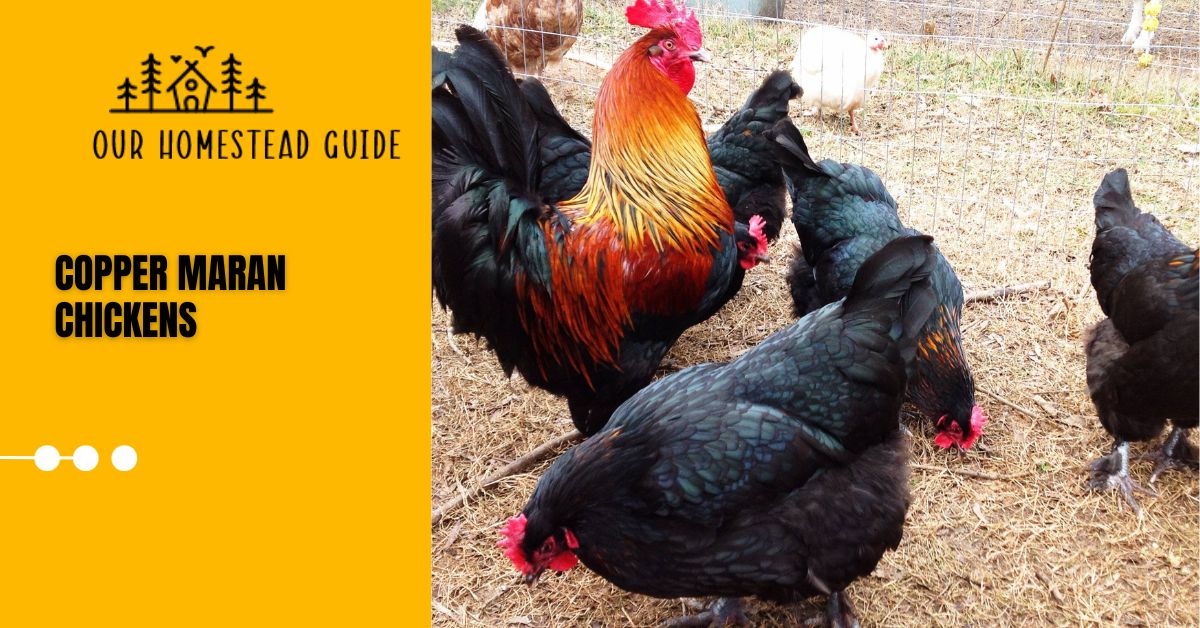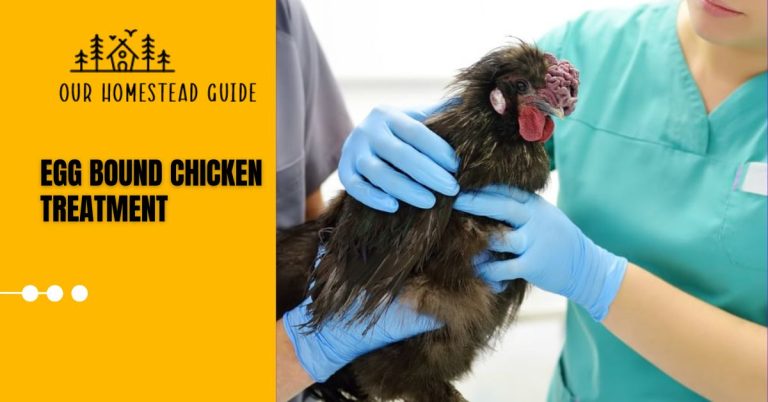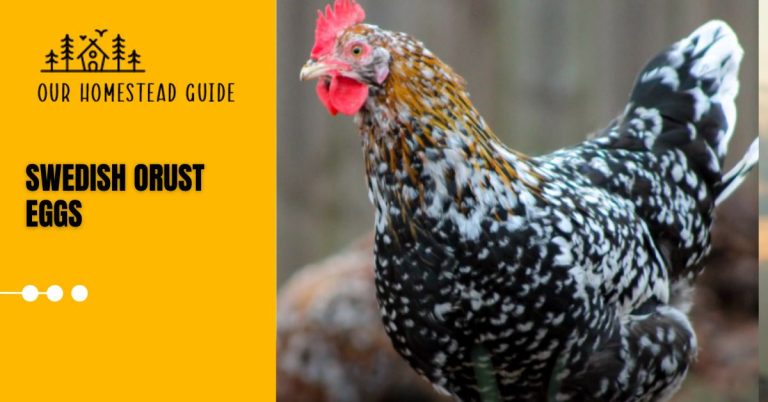Copper Maran Chickens: History, Appearance, Eggs and Care Guide
The Black Copper Maran chickens appears to be a popular hen right now. This stunning bird produces amazing eggs with a rich chocolate hue. Despite being existing for only a century or two, it has a turbulent past filled with ups and downs and almost extinction.
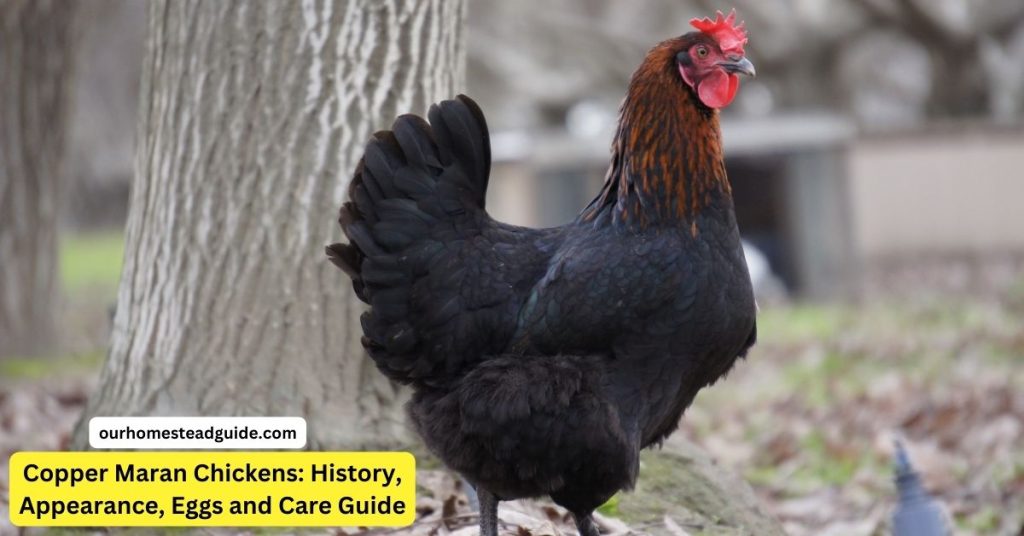
They are easily recognized due to their characteristic plumage, which is a blend of copper and black. It should be easy to raise chickens of this breed for pets, meat, or eggs.
Copper Maran Chickens Overview
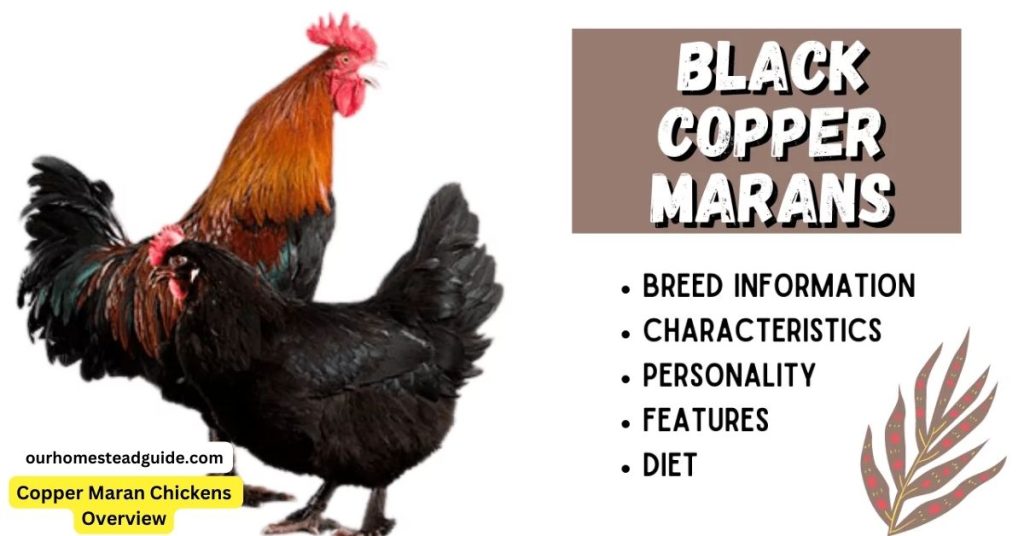
| Aspect | Details |
|---|---|
| Rooster Temperament | Gentle, non-aggressive towards humans. |
| Comparison with Other Breeds | Less aggressive compared to breeds like Rhode Island Red. |
| Hen Feather Characteristics | Extremely black with a green sheen; feathers are exceptionally soft. |
| Egg Characteristics | Eggs are darker than some breeds; not super dark but have a dark chocolate color with speckles. |
| Broodiness | Hens exhibit broodiness, but the effectiveness as mothers is uncertain. |
| Nesting Behavior | Can face challenges in nesting behavior, especially with limited nesting space. |
| Overall Evaluation | Preferred choice in the larger chicken breed category; appreciated for gentleness, soft feathers, broodiness, and colorful eggs. |
Black Copper Marans History
Marans chickens originated in a marsh area close to the French town of Marans in the 1900s. Even though they would frequently retain the birds for eggs, the locals first referred to the chickens in their region as “swamp chickens.”
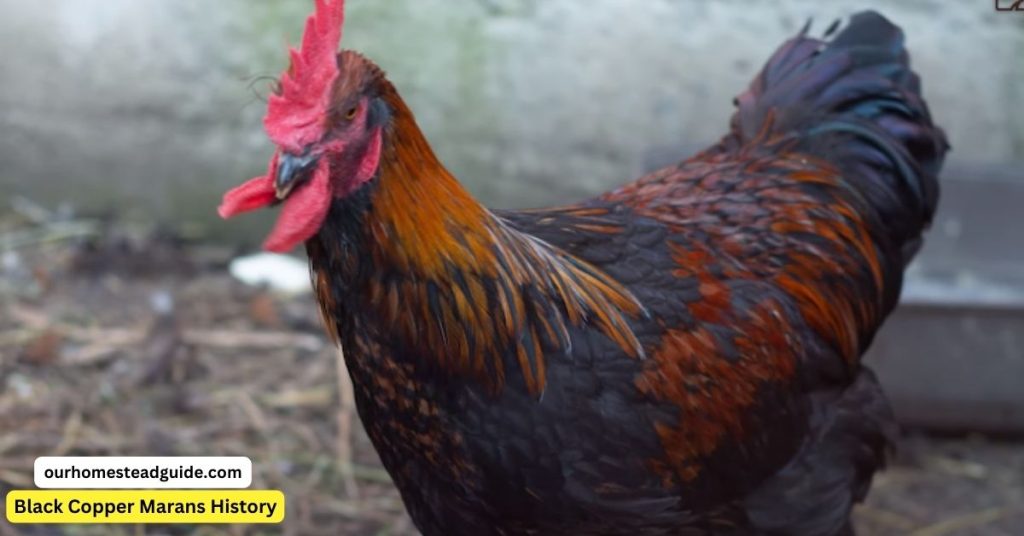
But in return for provisions, sailors would frequently bring other birds to the island. The “swamp chickens” were used by the locals to breed the new birds, and this finally produced the first Marans chickens.
Nobody knows for sure which birds comprise the genetic makeup of a Marans chicken because so many different species of birds were present in the town at the time. Nonetheless, aficionados of chickens started breeding them especially to produce more eggs.
This species was known as “Paradise fowl” by the locals for a while because of the dark red eggs that they deposited. Then, in 1921, several Marans were recognized as official breeds. Black Copper Marans, or French Black Copper Marans, were acknowledged as the species’ official hue in 1932.
Only a few Marans remained after the close of World War II, but with the right upkeep and selective breeding, these hens have survived to this day. Black Copper Marans are still uncommon in the US today.
Black Copper Marans Appearance
Given that their feathers are both black and copper, Black Copper Marans are well called. Nonetheless, their appearance varies according to their life stage.
What Color Eggs Do Black Copper Marans Lay?
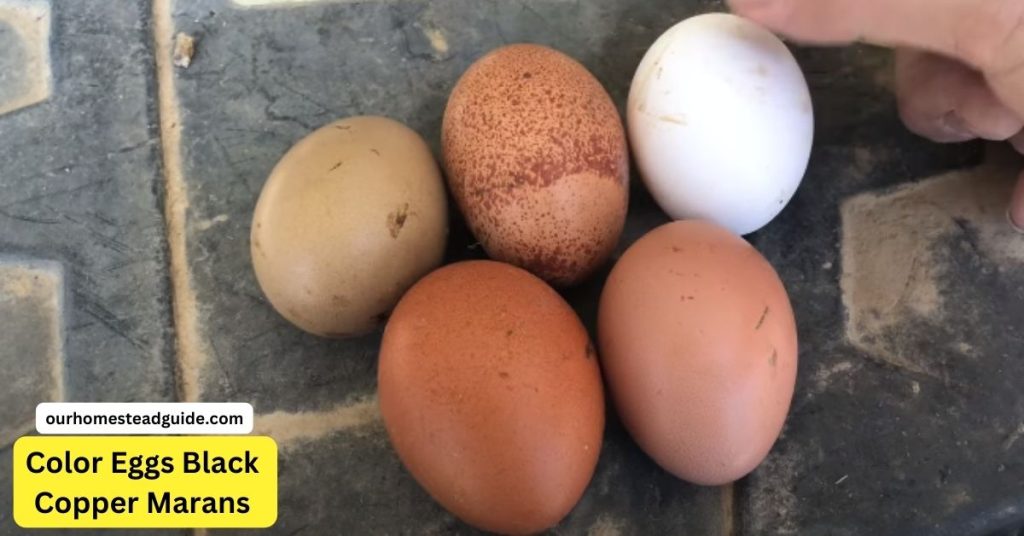
Beautiful dark brown eggs are laid by Black Copper Marans. These eggs can occasionally have a dark crimson appearance and are frequently characterized as having the hue of dark chocolate. These chicken eggs are among the most exquisitely colored ones.
Generally speaking, a chicken will seem darker the fewer eggs it produces. In addition, the eggs often start out the laying season the darkest and get lighter as the season progresses. It’s likened to “ink” gradually going out.
Speckles are also occasionally seen on eggs, but they are less frequent. Maran eggs are thought to be quite huge.
Black Copper Marans Adult Appearance
Black Copper Marans resemble both roosters and hens in appearance. Though smaller, hens have copper feathers on their head and wings and black feathers on their body. There are occasions when their black feathers appear somewhat green in color.
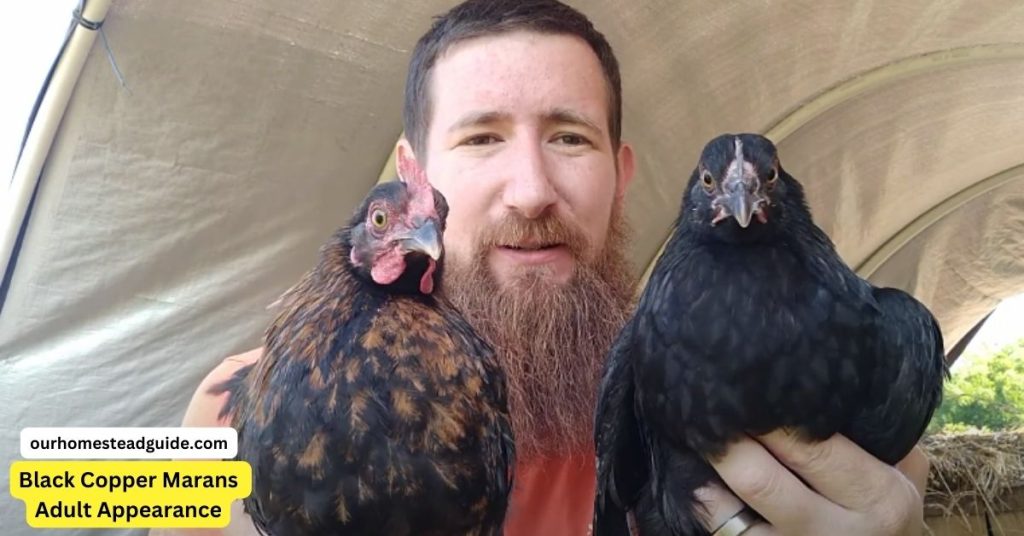
Their eyes are orange, and they always have red combs, waddles, and ear lobes. You can see that mature Marans’ bodies form a definite V when seen from the side.
Size and Weight
Marans are regarded as typical chicken sizes. Roosters weigh between seven and eight pounds, while hens typically weigh approximately 6.5 pounds.
Black Copper Marans Breed Standard
The American Poultry Association first acknowledged this hue of Marans in 2011. Thus, it’s a relatively young breed in the US.
According to the breed standard, Black Copper Marans must possess each of the aforementioned traits. The bird’s body should resemble an extended V when viewed from the side, and it should be “long and strong.” While hens’ legs will only measure 20 millimeters, roosters’ legs should measure 22 millimeters.
Black Copper Marans Temperament
The Black Copper Maran breed is kind. Although each bird’s level of friendliness might differ, it’s doubtful that they’ll want to cuddle up to you or perch on your lap.
Broodiness
This characteristic varies according to the specific bird. Some Black Copper Marans may sit on their eggs and care for their babies to some extent, but they’re considered to only exhibit ordinary broodiness.
Noise Levels
Though this varies from chicken to chicken, these birds are often fairly quiet. Some hens may tend to be louder and more “dramatic” than others. Their loudness levels are often comparable to those of their parents.
Do Black Copper Marans Get Along with Other Animals?
In general, Black Copper Marans get along well with other animals. But because this breed has some Gamecock genes, they could be more likely to mistreat other animals.
Compared to hens, roosters exhibit these dominating tendencies more frequently. However, if at all feasible, it might be advisable to confine your hens to areas with other chickens.
Black Copper Marans Care Requirements
Although Black Copper Marans are generally easy to care for, they do require special attention, just like any other chicken. Before purchasing these hens, keep the following points in mind.
Diet
A minimum of 16% protein must be included in the meals that Black Copper Marans consume. So, the majority of common chicken diets will function. while the hens are under stress, such as while they are molting or taking care of their young, it is advised to raise the minimum protein percentage.
This breed enjoys going on food hunts. So they can also find nourishment on their own if you let them explore. This will keep them occupied and help them acquire diversity in their meals. Give them plenty of room to walk around and explore, otherwise they may end up overweight.
Seeds, bugs, and worms are just a few things the hens will graze on when they’re foraging.
Habitat Setup
Given their size, Marans require a minimum of four to eight square feet per bird, but it’s best to offer them considerably more room. Your hens will be happier and healthier the more room they have. More room also prevents negative behaviors from developing in hens.
In the coop, each bird should have eight to ten inches of room for their roost. In the winter, they might all share a roost, but come summer, they’ll want more room to spread out. Additionally, placing the roosts at various heights will provide them with an ample amount of room to soar and explore as required.
A typical 12-inch by 12-inch box will work for adding nesting boxes to their environment. It is best to have one nesting box for every three birds.
Although they prefer to roam and graze, you may keep your hens restricted to a small area. Therefore, think about giving kids some freedom, even if it’s just occasionally. Unless they perceive danger, free-range hens seldom flee.
Temperature
These chicks can withstand almost any kind of weather. If they have a place to hide, most people can withstand extremely cold temperatures. In the heat, enough of shade is also crucial.
Nonetheless, in colder areas, chickens often produce fewer eggs. Several methods of egg storage can be found to extend the shelf life of eggs from other months. If you are not sure how old the eggs are, always test them.
Furthermore, because of their enormous combs, roosters are more likely than hens to suffer frostbite. For the colder months, you may supply a coop heater if you’re worried.
Health Concerns
Fortunately, there aren’t many health issues with these hens either. Marans are resistant to most illnesses. Given that they were nurtured in more squalid circumstances in the past, it might be related to their swamp beginnings.
Additionally, they may be healthier than other hens since they have cleaner behaviors. They prefer not to wander in excrement, which makes them less prone to illness than other chickens.
However, this breed is not immune to illness; all chickens do. Worms, mites, and lice are among the parasites that occasionally infect chickens. However, you may help prevent that by frequently cleaning their coop and taking them in for examinations.
Marans have a higher risk of obesity. Thus, make sure your hens are exercising and receiving enough of movement. Giving them extra room and chicken toys can help them stay in shape.
How to Breed Black Copper Maran Chickens
To increase the number of Black Copper Maran Chickens you breed, upgrade your coop with a rooster. After that, your chickens will naturally start laying fertilized eggs without your help.
However, if you don’t want any fertilized eggs, don’t maintain a rooster among the hens. In this manner, you’ll avoid producing additional hens and just gather eggs for sustenance. Furthermore, it may be simpler to take care of your herd without a rooster around because they have a higher tendency to harass other animals.
Egg Production
A hen will lay around three eggs per week. In other words, a single bird may produce 150–200 eggs annually.
Watch out for con artists if you purchase eggs from someone else. The breeder may show you a dark red egg, but give you the lighter colored ones instead since they are less attractive because the color of the eggs might fluctuate. Thus, be sure to visit a respectable breeder and don’t be hesitant to enquire in-depth about the hens.
Other Types of Marans
This magnificent breed has several varieties, including Black Copper Marans. Even though they are among the most prized, raising them isn’t as difficult as raising many others.
Here are some other types of Marans:
- Cuckoo
- Golden Cuckoo
- Black
- White
- Birchen
- Black Copper Neck
- Wheaten
- Colombian
- Black Tailed Buff
The primary distinction among all of these Marans is their hue. They may have different looks, but they have similar temperaments and maintenance needs. Therefore, you might want to try purchasing one of these other types if you are unable to locate a reliable breeder of Black Copper Marans.
Are Black Copper Marans the Right Chickens for You?
Should the stunning plumes and eggs of the Black Copper Marans leave you in awe, then perhaps these hens are the ones for you. They work well for novices as well as all varieties of chicken keepers.
They have few health issues and are simple to take care of. Additionally, they produce eggs often, giving you gorgeous reddish-brown eggs.
You might want to consider Black Copper Marans if you have an adequate area for keeping hens. Any of the Marans, though, would also make excellent first birds.
Is the Black Copper Marans Right for You?
The Black Copper Marans are not the superstar egg-laying breed you were hoping for.
But, the Black Copper Marans is the ideal choice if you’re searching for a gorgeously marked hen that produces very black eggs!
But keep in mind that the chickens that produce the fewest eggs are often the ones that lay the darkest. The egg’s shell color lightens as it moves through the system more quickly.
Do the eggs taste differently according to the Marans society’s color scale, which ranges from 1 to 9, with 9 being the darkest and purportedly the best?
I truly don’t know. A hen is not regarded as a Maran if she produces less than four eggs.
Be prepared to spend a significant amount of money if you’re interested in purchasing any of these rare stones.
Price of The Black Copper Marans
Indeed, hatchery birds are available for less than $10 per bird, but they are nothing in comparison to the higher-priced and higher-quality birds.
Is a bird from a reputable breeder too pricey for you? They might cost anything from $30.00 to $60.00 per bird. Try hatching eggs; they cost around $75.00 per dozen.
Take a look at these pictures showing the differences between hatchery and breeder stock if you feel the pricing is a “rip-off.”
With certain breeds, it can occasionally be challenging to distinguish between them, but not with this one. The feathers need to exhibit vibrant hues, devoid of dullness or tone.
The birds ought to be strong through the shoulders and stand tall and proud; the roosters in particular appear to carry their colors with great regalia.
Their huge combs require extra attention if housed in cooler areas. This kind of comb is tall and protrudes far from the rooster’s head.
The Maran is more prone to frostbite as a result. The comb may really die off as a result of severe frostbite.
If you are on a tight budget and would want to experience this unique breed, hatchery chicks could be your best option.
However, you might want to think about purchasing a Maran from a respectable breeder if your objective is to take home first prize at the exhibition.
Spending some time with an enthusiast can only help you learn more about your new feathered companion, since breeders are happy to chat about their favorite birds.
black copper maran hen vs rooster
The dazzling feathers and crowing are the main indicators of a Black Copper Maran hen from a rooster! The stylish guys are roosters, with their vivid black coats and glistening green plumage, complemented with reddish-copper neck and back feathers.
Conversely, hens are more understatedly stylish, with their black feathers and touches of copper around the neck. It’s also obvious by size: hens weigh 6.5 pounds, while roosters, who may weigh up to 8 pounds, are the greater show-offs.
And of course, only the hens will serenade you with their daily egg-laying announcements (while the roosters take care of the wake-up calls!).
Most Frequently Asked Questions!
What is a Copper Maran chickens?
France is the origin of the French chicken breed known as Copper Marans. They are prized for their capacity to produce dark brown eggs as well as their stunning coppery plumage.
What color eggs do Copper Marans lay?\
Dark brown eggs, which can vary from rich chocolate brown to lesser tints, are well-known to be laid by Copper Marans.
How many eggs do Copper Marans typically lay?
Hens of Copper Marans typically deposit 150–200 eggs a year. But this can change based on things like genetics, nutrition, and general medical attention.
What is the temperament of Copper Marans?
The prevailing consensus is that copper marans are peaceful and amiable birds. They are frequently prized for their friendly disposition and capacity for producing eggs, making them a viable option for backyard flocks.
Do Copper Marans require any special care?
Copper Marans need regular care, just like any other breed of chicken, which includes having access to clean water, a healthy meal, and a nice place to live. It’s crucial to provide them with enough room, safety from wolves, and access to quality veterinary care.
Are Copper Marans good for free-ranging?
Yes, given their overall activity level and love of foraging for plants and insects, Copper Marans may make excellent free-range pets. To keep them safe from predators, it’s crucial to make sure the location is secure.
Can I keep Copper Marans in a mixed flock?
In a mixed flock, Copper Marans may live side by side with various varieties of chickens. To avoid aggressiveness, it’s critical to carefully introduce new hens and keep an eye on how they get along with one another.
Conclusion:
To sum up, the Black Copper Maran Chickens are among the most desirable choices available for poultry. They provide a calm, easy-to-manage bird that may fulfill a range of purposes, even if they might not be the largest or most prolific breeds.
you may also like this article.
Polish Chicken: Varieties, Appearance, & Care Complete Guide

